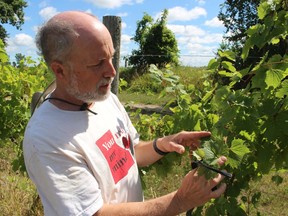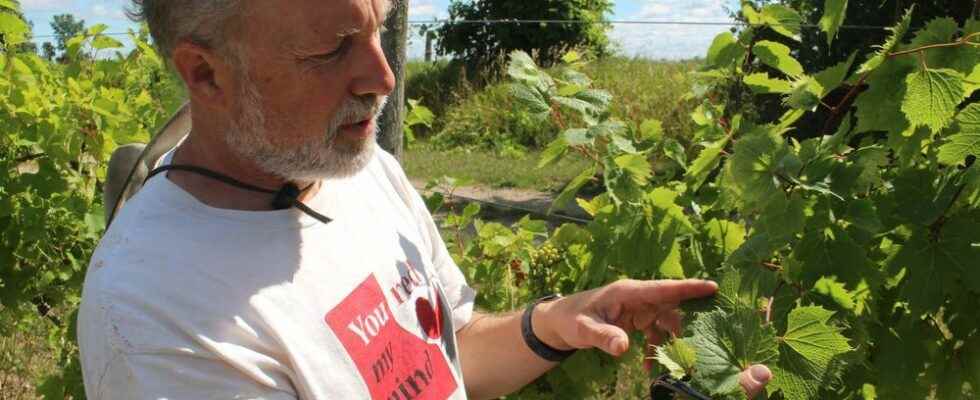The owner of a Lambton County vineyard is seeking the Lambton Federation of Agriculture’s help to protect fruit and vegetable growers from damage caused by herbicide drifting after being sprayed on cash crops.

The owner of a Lambton County vineyard is seeking the Lambton Federation of Agriculture’s help to protect fruit and vegetable growers from damage caused by herbicide drifting after being sprayed on cash crops.
A resolution Marc Alton, with Alton Farms Estate Winery in Plympton-Wyoming, presented to the federation in August is set to be considered at the county farm organization’s board meeting in September.
It would call on the group’s provincial organization, the Ontario Federation of Agriculture, to work with the province to create buffer zones near high-value fruit and vegetable crops where use of phenoxy herbicides wouldn’t be allowed.
Alton presented the resolution at a federation meeting held in August at the winery he and his wife, Anne Kurtz-Alton, run on Aberarder Line.
They became modern pioneer grape growers in the Lake Huron shoreline region after purchasing the farm in 2005 and planted grape vines.
Since then, Alton has been watching damage to vines he attributes to the herbicides widely used by farmers growing crops like soybeans, corn and wheat to control weeds in their fields.
“In the last 10 years I’ve been seeing regular hits of phenoxy herbicides,” he said.
A few areas of the winery’s grape vines “get hit every year” and “they’re just getting weaker and weaker,” Alton said.
“If the herbicide gets into the root, it also affects the health of the plant so it may die off over the winter,” he said.
“The bigger problem with winemaking is you’ll get a bunch of grapes and about 10 per cent won’t be ripe,” which he believes is also connected to the impact of the herbicide.
Grapes that haven’t ripened can impact how they can be used in winemaking, Alton said.
Testing hasn’t indicated concerns the herbicide is showing up in wines, “but if we’re losing vines and we’re having problems with winemaking, then that’s the issue,” he said.
Alton said it can be difficult to trace where the herbicide is coming from.
“The answer is not, ‘blame a person.’ The answer is don’t use that herbicide, or be extremely careful,” he said.
“I think the answer is stop using that, either in the area of fruit trees or grape vines, within a certain radius . . . or take it off the market,” Alton said.
He said there was “some pushback” from cash crop farmers when he presented the resolution at the meeting in August.
“I have a feeling it will get worse and worse the higher it goes,” Alton said.
Gary Martin, president of the Lambton Federation of Agriculture, said, “We’re going to discuss it further” at the September board meeting.
When resolutions from federation members are endorsed locally, “we send them up to the OFA (Ontario Federation of Agriculture) and the OFA board, as a whole, will discuss them and say whether they support them or not,” Martin said.
Resolutions supported by the provincial board are then presented to the government.
“It’s an issue,” Martin said about concerns with herbicide drift.
“I’m not sure what kind of recourse fruit operators would have,” he said. “That’s something we’d have to research.”
“Grapes are very sensitive to Group 4 (phenoxy) herbicides,” Belinda Sutton, a spokesperson for Ontario’s Ministry of Agriculture, Food and Rural Affairs, said in an e-mail.
“These herbicides are very effective against broadleaf weeds and are commonly applied to field crops,” she said.
“In Ontario, corn yields are reduced by an average of 51.4 per cent and soybean yields are reduced by an average of 38.1 per cent when weeds are not controlled,” Sutton said.
“Weed competition represents losses of $1.4 billion in field corn and $1 billion in soybean, using 2021 provincial production levels and the current cash price of both commodities,” she said.
Environmental conditions at the time of application can increase the risk of “off-target drift with certain Group 4 herbicides,” Sutton said. “That is why the product label provides directions for spray drift management.”
Responsibility for responding to issues of herbicide drift remains with the Ministry of the Environment, Conservation and Parks, Sutton said.
Alton said he encourages other fruit and vegetable growers to report signs of herbicide drift damage to the ministry.
“The more reports they get, the more they’re start looking at this,” he said.
“If we’re really going to encourage more grape growing in this area we need to be aware of it.”
